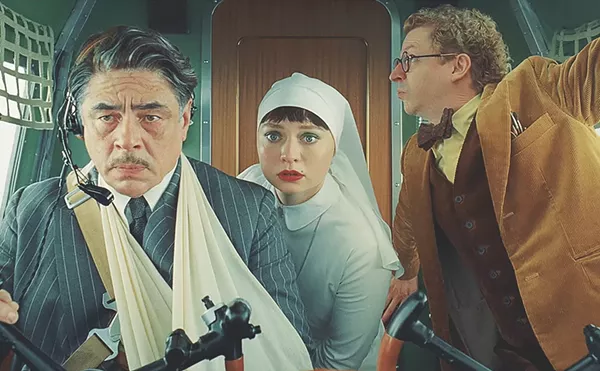
Audio By Carbonatix
[
{
"name": "GPT - Leaderboard - Inline - Content",
"component": "35519556",
"insertPoint": "5th",
"startingPoint": "3",
"requiredCountToDisplay": "3",
"maxInsertions": 100,
"adList": [
{
"adPreset": "LeaderboardInline"
}
]
}
]
People ask, "How did you get in there?" What they really want to know is if they are likely to end up in there as well. I can’t answer the real question. All I can tell them is, it’s easy. And it is easy to slip into a parallel universe. There are so many of them: worlds of the insane, the criminal, the crippled, the dying, perhaps of the dead as well. These worlds exist alongside this world and resemble it, but are not in it.
That’s how Susanna Kaysen opens Girl, Interrupted, an account of her stay at a Massachusetts psychiatric hospital during the late 1960s. In this memoir, Kaysen employs the same sparse, hallucinatory prose of her novel, Asa, As I Knew Him, bringing the reader directly into the mind of the narrator, a young woman as obsessive as she is intelligent. A surprise best seller in 1993, Girl, Interrupted details Kaysen’s experiences at McLean Hospital, a pricey and prestigious institution whose famous clientele included Sylvia Plath, Robert Lowell and James Taylor.
"A very distinguished group of artists, when they were having their adjustment-to-society problems, often went to McLean," explains producer Douglas Wick. As someone who loves Beat poetry, Wick recognized Kaysen’s experiences as akin to those of Allen Ginsberg, whose societal maladjustment (along with the deviant "illness" of homosexuality) meant a period in a mental hospital.
In Girl, Interrupted, Kaysen explores a question central to the Beats, says Wick, namely "as you were beginning to feel a lot and you were in a world that valued feeling less, how could you possibly find a place?"
Actress and executive producer Winona Ryder also responded immediately to Kaysen’s book and began corresponding with the author. The pair didn’t meet face to face until years later, when Ryder was playing Kaysen in the film version.
"It’s one of the best books I’ve ever read," Ryder enthuses, "and what struck me was its brutal honesty, cut with such humor, and without this droning self-indulgence. Also, that it was about all these women, but had an edge. It wasn’t saccharine sweetness."
In her memoir, Susanna Kaysen (whom Ryder describes as "an eternal rebel") leaves unanswered the question of the severity of her mental illness. Diagnosed with borderline personality disorder, Kaysen wonders aloud if her institutionalization was based on a suicide attempt (she downed a bottle of aspirin with vodka) or the fact that she didn’t adhere to the era’s rigid behavioral code for women (one of her "symptoms" was promiscuity).
Ryder believes it was more the latter, saying, "I do not think Susanna belonged in an institution. I mean, she saw a psychiatrist for 20 minutes and they locked her up for two years. That’s absurd."
For others involved in the film, the distinction isn’t quite so cut-and-dried.
"Susanna always teases you back and forth," explains Wick, "between ‘It’s nuts outside – they’re killing the boys in Vietnam – the world’s gone crazy,’ and ‘It’s cool to be in here – they’re all jerks.’ But just when you’re getting kind of self-satisfied and ready to make a conclusion, she’ll give you a peek at a very disturbed young woman."
"She did try to kill herself," asserts producer Cathy Konrad. "She actually did take action. So right out of the gate, there is a distinction between (what she experienced and) a general malaise that we all may feel – so we felt we had to address that. But it was a fine line of trying to say, ‘What is this girl’s problem?’"
When writer-director James Mangold (Heavy, Cop Land) asked himself the question – "Was she a girl going through a rough adolescence or was she fucked up?" – he made several crucial decisions. First, the very nature of McLean meant he wouldn’t be making a female version of One Flew Over the Cuckoo’s Nest.
"She doesn’t tell a story of being abused," Mangold explains. "She tells a much more magical tale of landing in this circumscribed universe and being unable or unsure how to get out, or even if she was worthy of getting out. A young woman who does a sort of half-hearted attempt at suicide these days would be in outpatient counseling. The knee-jerk reaction at that moment was to send someone away to where the best and brightest could look at your child a little while and hopefully save them."
Mangold was also careful not to perpetuate the clichés of movies such as Ordinary People and Good Will Hunting, which "have this big secret in the end, the third-act revelation which serves as a key to unlocking this strange, ambiguous protagonist."
He considers this approach reductive and simplistic, especially considering that it was the enigmatic nature of Kaysen’s story that attracted him in the first place.
"Susanna really cogently puts together an argument," Mangold explains, "that she never knew what happened to her and never will. Part of all of the magic, mystery or darkness of it is that it was a shadow – a cloud, a period – that there will be no explanation for. This protagonist had a problem, but the scale of it is completely up to the audience to decide."





